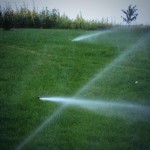By Cheryl Boyer, Professor and Extension Specialist
While some parts of Kansas are experiencing relief from drought (let’s celebrate with far Western Kansas!), significant portions of the state continue to need water. The current map of Kansas on the U.S. Drought Monitor shows only 9 of our 105 counties with no drought. That means that 91% of Kansas counties are experiencing some combination of abnormally dry, moderate drought, severe drought, extreme drought, or exceptional drought.
Having enough water for human needs and health will always (and should) take priority over landscape use. So how do we adapt? Here are some best practices for water conservation in the landscape. Use these ideas as regular practices for your work and as opportunities to educate consumers on ways they can contribute to our ongoing water needs.
- Make a plan.
- Consider factors on each site that may affect water use, like steep slopes, shading, and overall landscape goals.
- Improve soil conditions.
- Get a soil test! Identify nutrient status, organic matter content, and pH to help you identify needs and approaches.
- Choose appropriate plants.
- Understanding which plants can tolerate Kansas conditions, as well as the specific site conditions for the project, will help place the right plants in the right place.
- Water slowly, deeply, and infrequently.
- Observe the weather and water based on plant needs. Soaker hoses, drip irrigation, sprinkler systems, and micro-drip water bags/buckets are all good options to achieve this best practice.
- Use mulch.
- Organic mulch will increase soil quality as it breaks down while keeping soil cooler, reducing weed pressure, and helping soil retain water.
For more information (for yourself or to share on your organization’s online platforms) based on learning style, check out:
- Written:
- “Water Conservation in the Home Landscape” KSRE Publication MF2066
- Water-Saving Irrigation Techniques healthy yards strategy: Kansas Healthy Yards and Communities (KHYC)
- Visual:
- “Water Wise Way to Irrigate Trees” KHYC video
- “How Often Should You Water Your Lawn?” KHYC video
- “Rain Sensors Save Water” KHYC Video
- Auditory:
- “Landscape Water Conservation” on KSRE Sound Living Podcast
- Kinesthetic:
- KSRE 4-H Environmental Sciences project ideas


















